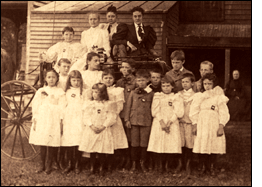
I noticed it ran
only half the length of the building itself. The other
half was built directly on the earth. Odd to not have
a full basement, I thought, but did not question it
too much. But when I reached the meeting hall and began
pulling up some floorboards that needed to be repaired,
I made an amazing discovery. Built into the earth, underneath
the floor, was the small brick chamber, completely separate
from the basement, with no other access except through
the floor of the meeting hall. After consulting some
historical experts, I learned that the room was once
used to house fugitive slaves.
Looking down into
the dark chamber, I paused to consider the inhabitants'
fear, courage, and hope. And the Quakers who helped
them find their freedom. This unassuming Quaker façade
had managed to fool everyone for over a century, making
it an ideal station stop on the Underground Railroad.
Now it will forever be a piece of history within a piece
of history.
|
 |